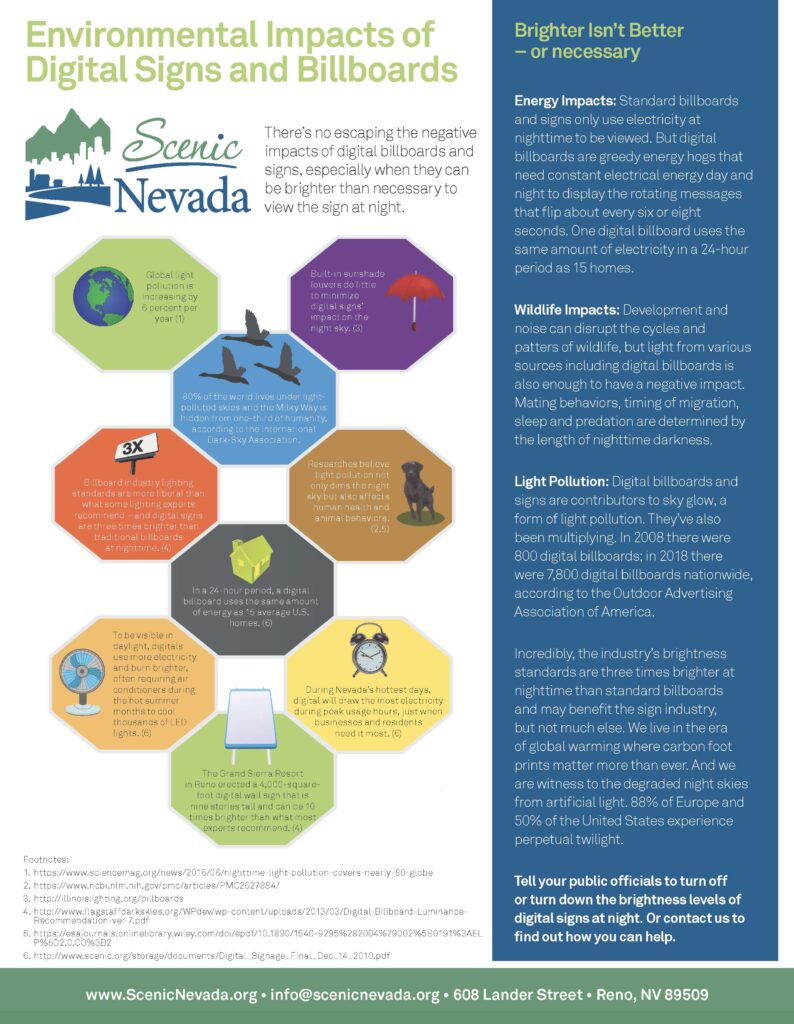The Real Price of Billboards to Our Communities
As a matter of public policy, why should the State allow any more billboards when the existing ones are — and always will be — economic drains to the taxpayers who fund the public roads? Even if permit fees covered all administrative costs, the cost of individual relocations, condemnations, and litigation is not recovered; and the construction delay costs caused by removal, relocation, and condemnation cannot be quantified or recovered.
The outdoor advertising industry testified that they pay $20 million in local property taxes. For 30,000 billboards, that amounts to $666.66 per billboard to be split among the local taxing authorities. Income received from outdoor advertising is exempt from paying State sales taxes.
STATE OF TEXAS*
INCOME for Fiscal Year 2002: $703,802 (per TxDOT public information request)
1. Permit fees, new and renewals | $600,000
2. License fees | $80,000
3. Miscellaneous | $23,802
4. Sales taxes (from advertising revenues) | $O (exempt)
EXPENSES for Fiscal Year 2002: $1,540,761 (per TxDOT & A.G. public information requests)
1. Relocation of 10 billboards | $133,961**
2. Purchase/condemnation of 8 billboards | $74,800***
3, TxDOT monitoring, administration, and regulation | $l,242,000
4. Legal fees approx. $90,000 (per Texas Attorney General’s response to public information request). These fees are paid for the A.G.’s representation of TxDOT in billboard company disputes.
5. Lost time due to highway construction delays | NOT QUANTIFIABLE
* Does not include income and expenses to individual cities. In general, sufficient permit fees are collected to pay for a city’s administrative costs, however, unrecoverable costs include legal fees and condemnation costs. In 2002, for example, Fort Worth condemned 2 billboards for a total cost of approx. $1.2 million.
** At $13,396 per relocation, TxDOT is already obligated to pay, over time, approx. $100.4M if 7,500 more billboards have to be relocated or $50.2 M if 3,750 more BBs have to be relocated.
*** At $9,350 per condemnation, TxDOT is already obligated to pay, over time, approx. $70M if 7,500 more billboards are condemned or $35M if 3,750 more BBs are condemned.
Digital Billboards
In the US 1.0% or 5,500 of approximately 550,000 billboards are digital. In Texas, 0.88% or 308 of approximately 35,000 billboards are digital. In Texas cities, digital billboards operate in 8.2% or 100 of the 1,215 incorporated Texas cities

Digital signs raise controversial issues and legal challenges across the US. The following are illustrative examples:
Digital billboard legislation is met with adverse public reaction
- Bucktown Residents: Electronic Billboard Is Gaudy, Annoying
- Neighborhood wins battle, digital billboard removed
- Allentown residents decry digital billboard plan
- Albany residents seeing red over proposed digital billboards
- Richmond, CA residents overwhelmingly reject digital billboards
In response to adverse public reaction, local governments have restricted or prohibited digital billboards
- Alpha Borough Council considers digital billboard restrictions
- Supervisors Reverse Prior Vote, Agree to Ban Off-Site Digital Billboards
- Des Moines City Council bans new billboards
Digital billboards create legal challenges and expense to governmental entities
- Clear Channel Tries to ‘Walk Away’ from Billboard Deal
- Scenic Arizona v. City of Phoenix
- FHWA ruling on digital billboards
- Judge rules against digital billboards in Knoxville
- After lengthy legal battle, controversial billboard comes down in Peabody
- NJ towns can ban electronic billboards, court says
- Margate Causeway digital billboard co. settles with couple
Digital billboards raise serious highway safety concerns
Safety issues surrounding driver distraction are a growing concern. There is substantial data that directly links cell phone usage and texting to accidents and serious safety threats on our roadways. Similarly, it can be argued that digital billboards, positioned along public roadways, changing messages every 8 seconds, seem by design intended to distract a driver’s attention from the roadway.
Due to the small number of digital billboards in the U.S., data on the driver distraction caused by them is limited. The most recent government sponsored digital billboard safety study was issued in 2013 by the Federal Highway Administration (FHWA) here.
The first comprehensive review of the FHWA digital billboard safety study says the study’s conclusions are seriously flawed. Critique of FHWA digital billboard safety study.
Additional reports also raise serious highway safety concerns.
- Digital billboards play pornography for unsuspecting drivers
- Insurance industry concerned about digital billboard safety risks
- Digital billboards along Ontario’s highways worry paramedics
- Swedish study shows digital billboards distract drivers
- Preliminary results of Michigan digital billboard crash study
Digital billboards adversely affect economic development
- Kansas City billboard holds up downtown hotel project
- Tacky billboards knocked $30,000 off home values in Philadelphia
- Destination marketer says billboards a drag on business appeal

